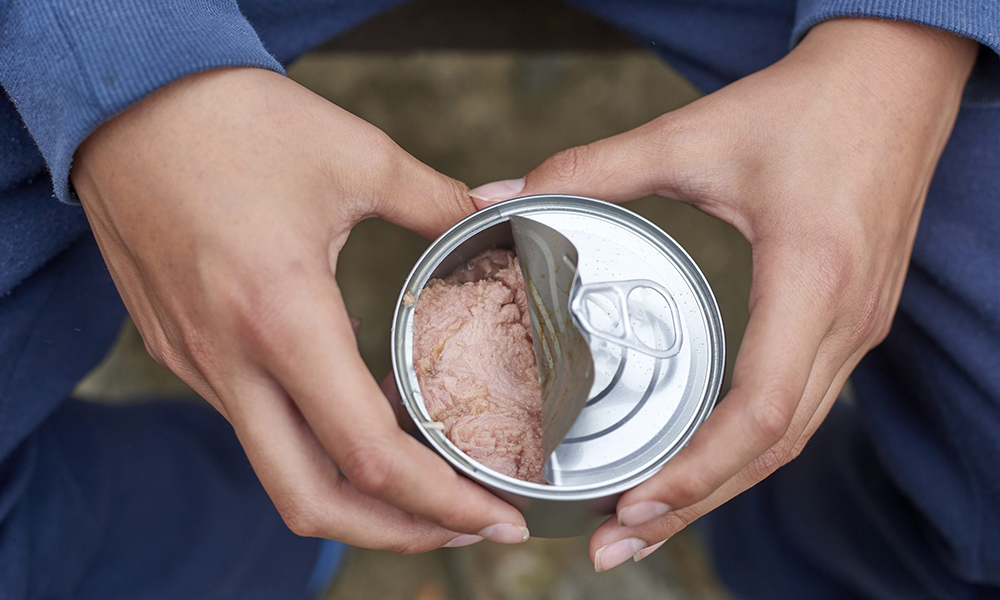
隨著人們?nèi)找嬉庾R(shí)到蛋白粉,、黑巧克力和糙米等食物中隱藏著毒素,自然會(huì)對(duì)自己常吃的其他食物產(chǎn)生疑問(wèn),。魚(yú)類可能就是其中之一,,其中某些品種已知神經(jīng)毒素汞的含量較高。當(dāng)你在享用金槍魚(yú)沙拉或壽司卷時(shí),,或許會(huì)思考:究竟攝入多少汞才算超標(biāo),?
食品科學(xué)家艾比·蒂爾對(duì)《財(cái)富》雜志表示:“唯一需要注意的是,不要每周多次食用汞含量較高的魚(yú)類?!?/p>
據(jù)美國(guó)環(huán)境保護(hù)署(Environmental Protection Agency)介紹,,汞既是自然存在的元素(來(lái)自火山活動(dòng)),也是工業(yè)污染,、燃煤,、發(fā)電廠和化石燃料燃燒的副產(chǎn)品。這些活動(dòng)將毒素釋放到空氣中,,隨后沉積回水體和底泥,,轉(zhuǎn)化為更具毒性的甲基汞形態(tài)。
高濃度汞暴露會(huì)損害各年齡段人群的大腦,、心臟,、腎臟、肺部和免疫系統(tǒng)——但對(duì)胎兒和兒童威脅最大,。胎兒的大腦和神經(jīng)系統(tǒng)發(fā)育面臨風(fēng)險(xiǎn),,而兒童可能出現(xiàn)認(rèn)知思維、記憶力,、注意力,、語(yǔ)言能力、精細(xì)運(yùn)動(dòng)技能和視覺(jué)空間能力的退化,。
蒂爾指出,,魚(yú)類是被汞污染的主要食物來(lái)源。值得慶幸的是,,只有少數(shù)幾種魚(yú)類值得警惕,。
哪些魚(yú)類汞含量最高?
環(huán)境工作組織(Environmental Working Group)高級(jí)科學(xué)家塔莎·斯托伊貝爾解釋道,,位于食物鏈頂端的魚(yú)類汞含量最高,。
這些魚(yú)類包括:
? 大西洋馬鮫
? 鯊魚(yú)
? 劍魚(yú)
? 槍魚(yú)
? 金槍魚(yú)
這些魚(yú)類因?yàn)椴妒丑w內(nèi)已含汞的小型魚(yú)類,導(dǎo)致汞在體內(nèi)產(chǎn)生生物累積效應(yīng),,因此汞含量最高,。
蒂爾表示:“它們有時(shí)一口就能吞下數(shù)百條小魚(yú)?!彼忉尫Q,,汞進(jìn)入魚(yú)體內(nèi)后,會(huì)與肌肉和蛋白質(zhì)結(jié)合并長(zhǎng)期留在體內(nèi),,而且會(huì)隨著捕食其他含汞魚(yú)類不斷積累,。她補(bǔ)充道:“當(dāng)我們食用這些蛋白質(zhì)時(shí),汞就會(huì)進(jìn)入人體,,與我們不同的蛋白質(zhì)和肌肉結(jié)合,。”
汞含量較高的魚(yú)類的安全攝入量
對(duì)于已知汞含量最高的掠食性魚(yú)類,斯托伊貝爾建議“盡量少食或不食”,。
美國(guó)疾病預(yù)防控制中心(Centers for Disease Control and Prevention)參考食品藥品管理局(Food and Drug Administration)制定的魚(yú)類汞含量分級(jí)表,,為孕婦、哺乳期婦女和幼兒提供以下指南:
? 保持魚(yú)類品種多樣化,。
? 若食用親友捕撈的魚(yú)類,,需查詢魚(yú)類食用建議。若無(wú)此類建議,,當(dāng)周僅可食用一份,,且不再攝入其他魚(yú)類。
? 避免食用“應(yīng)避免選擇”類(FDA表格標(biāo)注)魚(yú)類,,切勿將此類魚(yú)肉喂食給兒童,。 建議優(yōu)先選擇“最佳選擇”和“次優(yōu)選擇”類別的多種魚(yú)類。
對(duì)成年人的建議:
? 每周食用2-3份(8-12盎司,;1份=烹飪前測(cè)量的4盎司)FDA表格標(biāo)注的“最佳選擇”類魚(yú)類,,或1份(4盎司)“次優(yōu)選擇”類魚(yú)類。
蒂爾表示:“汞會(huì)干擾大腦發(fā)育過(guò)程,。幼兒,、孕婦和哺乳期母親需要格外注意?!?/p>
替代選擇低汞魚(yú)類
專家建議,,選擇體型較小、非掠食性魚(yú)類既能獲取海鮮的營(yíng)養(yǎng),,又可避免汞攝入過(guò)量,。
蒂爾表示:“這些小型魚(yú)類的攝食量遠(yuǎn)不及大型掠食性魚(yú)類。雖然它們體內(nèi)也含汞,,但含量明顯低于其他魚(yú)類,。”
可參考FDA的詳細(xì)列表,,環(huán)境工作組織也發(fā)布了最安全的海鮮選擇指南,。低汞魚(yú)類包括:
? 鱈魚(yú)
? 三文魚(yú)
? 沙丁魚(yú)
? 羅非魚(yú)
? 黑線鱈
? 鱒魚(yú)
蒂爾表示,在食用這些魚(yú)類時(shí),,“即使每周吃2-3份也無(wú)需擔(dān)心”,。
斯托伊貝爾補(bǔ)充說(shuō),三文魚(yú)等魚(yú)類富含的omega-3脂肪酸能有效抵消汞的負(fù)面影響,。她表示:“食用富含omega-3的魚(yú)類時(shí),,這些脂肪酸能起到保護(hù)作用,這對(duì)大腦發(fā)育非常有益,。”
這一結(jié)論源自環(huán)境工作組織2018年的研究。研究發(fā)現(xiàn),,改用低汞魚(yú)類不僅能在三個(gè)月內(nèi)顯著降低體內(nèi)汞含量,,omega-3的已知益處還能為兒童大腦發(fā)育提供保護(hù)機(jī)制。
斯托伊貝爾表示:“選擇低汞魚(yú)類是最佳方案,。低汞含量與omega-3的結(jié)合能帶來(lái)最大健康效益,。”(財(cái)富中文網(wǎng))
譯者:劉進(jìn)龍
審校:汪皓
隨著人們?nèi)找嬉庾R(shí)到蛋白粉,、黑巧克力和糙米等食物中隱藏著毒素,,自然會(huì)對(duì)自己常吃的其他食物產(chǎn)生疑問(wèn)。魚(yú)類可能就是其中之一,,其中某些品種已知神經(jīng)毒素汞的含量較高,。當(dāng)你在享用金槍魚(yú)沙拉或壽司卷時(shí),或許會(huì)思考:究竟攝入多少汞才算超標(biāo),?
食品科學(xué)家艾比·蒂爾對(duì)《財(cái)富》雜志表示:“唯一需要注意的是,,不要每周多次食用汞含量較高的魚(yú)類?!?/p>
據(jù)美國(guó)環(huán)境保護(hù)署(Environmental Protection Agency)介紹,,汞既是自然存在的元素(來(lái)自火山活動(dòng)),也是工業(yè)污染,、燃煤,、發(fā)電廠和化石燃料燃燒的副產(chǎn)品。這些活動(dòng)將毒素釋放到空氣中,,隨后沉積回水體和底泥,,轉(zhuǎn)化為更具毒性的甲基汞形態(tài)。
高濃度汞暴露會(huì)損害各年齡段人群的大腦,、心臟,、腎臟、肺部和免疫系統(tǒng)——但對(duì)胎兒和兒童威脅最大,。胎兒的大腦和神經(jīng)系統(tǒng)發(fā)育面臨風(fēng)險(xiǎn),,而兒童可能出現(xiàn)認(rèn)知思維、記憶力,、注意力,、語(yǔ)言能力、精細(xì)運(yùn)動(dòng)技能和視覺(jué)空間能力的退化,。
蒂爾指出,,魚(yú)類是被汞污染的主要食物來(lái)源。值得慶幸的是,,只有少數(shù)幾種魚(yú)類值得警惕,。
哪些魚(yú)類汞含量最高,?
環(huán)境工作組織(Environmental Working Group)高級(jí)科學(xué)家塔莎·斯托伊貝爾解釋道,位于食物鏈頂端的魚(yú)類汞含量最高,。
這些魚(yú)類包括:
? 大西洋馬鮫
? 鯊魚(yú)
? 劍魚(yú)
? 槍魚(yú)
? 金槍魚(yú)
這些魚(yú)類因?yàn)椴妒丑w內(nèi)已含汞的小型魚(yú)類,,導(dǎo)致汞在體內(nèi)產(chǎn)生生物累積效應(yīng),因此汞含量最高,。
蒂爾表示:“它們有時(shí)一口就能吞下數(shù)百條小魚(yú),。”她解釋稱,,汞進(jìn)入魚(yú)體內(nèi)后,,會(huì)與肌肉和蛋白質(zhì)結(jié)合并長(zhǎng)期留在體內(nèi),而且會(huì)隨著捕食其他含汞魚(yú)類不斷積累,。她補(bǔ)充道:“當(dāng)我們食用這些蛋白質(zhì)時(shí),,汞就會(huì)進(jìn)入人體,與我們不同的蛋白質(zhì)和肌肉結(jié)合,?!?/p>
汞含量較高的魚(yú)類的安全攝入量
對(duì)于已知汞含量最高的掠食性魚(yú)類,斯托伊貝爾建議“盡量少食或不食”,。
美國(guó)疾病預(yù)防控制中心(Centers for Disease Control and Prevention)參考食品藥品管理局(Food and Drug Administration)制定的魚(yú)類汞含量分級(jí)表,,為孕婦、哺乳期婦女和幼兒提供以下指南:
? 保持魚(yú)類品種多樣化,。
? 若食用親友捕撈的魚(yú)類,,需查詢魚(yú)類食用建議。若無(wú)此類建議,,當(dāng)周僅可食用一份,,且不再攝入其他魚(yú)類。
? 避免食用“應(yīng)避免選擇”類(FDA表格標(biāo)注)魚(yú)類,,切勿將此類魚(yú)肉喂食給兒童,。 建議優(yōu)先選擇“最佳選擇”和“次優(yōu)選擇”類別的多種魚(yú)類。
對(duì)成年人的建議:
? 每周食用2-3份(8-12盎司,;1份=烹飪前測(cè)量的4盎司)FDA表格標(biāo)注的“最佳選擇”類魚(yú)類,,或1份(4盎司)“次優(yōu)選擇”類魚(yú)類。
蒂爾表示:“汞會(huì)干擾大腦發(fā)育過(guò)程,。幼兒,、孕婦和哺乳期母親需要格外注意?!?/p>
替代選擇低汞魚(yú)類
專家建議,,選擇體型較小、非掠食性魚(yú)類既能獲取海鮮的營(yíng)養(yǎng),,又可避免汞攝入過(guò)量,。
蒂爾表示:“這些小型魚(yú)類的攝食量遠(yuǎn)不及大型掠食性魚(yú)類,。雖然它們體內(nèi)也含汞,但含量明顯低于其他魚(yú)類,?!?/p>
可參考FDA的詳細(xì)列表,環(huán)境工作組織也發(fā)布了最安全的海鮮選擇指南,。低汞魚(yú)類包括:
? 鱈魚(yú)
? 三文魚(yú)
? 沙丁魚(yú)
? 羅非魚(yú)
? 黑線鱈
? 鱒魚(yú)
蒂爾表示,在食用這些魚(yú)類時(shí),,“即使每周吃2-3份也無(wú)需擔(dān)心”,。
斯托伊貝爾補(bǔ)充說(shuō),三文魚(yú)等魚(yú)類富含的omega-3脂肪酸能有效抵消汞的負(fù)面影響,。她表示:“食用富含omega-3的魚(yú)類時(shí),,這些脂肪酸能起到保護(hù)作用,這對(duì)大腦發(fā)育非常有益,?!?/p>
這一結(jié)論源自環(huán)境工作組織2018年的研究。研究發(fā)現(xiàn),,改用低汞魚(yú)類不僅能在三個(gè)月內(nèi)顯著降低體內(nèi)汞含量,,omega-3的已知益處還能為兒童大腦發(fā)育提供保護(hù)機(jī)制。
斯托伊貝爾表示:“選擇低汞魚(yú)類是最佳方案,。低汞含量與omega-3的結(jié)合能帶來(lái)最大健康效益,。”(財(cái)富中文網(wǎng))
譯者:劉進(jìn)龍
審校:汪皓
As we become increasingly aware of toxins lurking in our food—including protein powder, dark chocolate, and brown rice—it’s only natural to wonder about other foods you regularly eat. One of those foods might be fish, some of which is known to be high in mercury—a neurotoxin. And while chowing down on tuna salad or a sushi roll you may be wondering: How much mercury is too much?
“All you have to worry about is, don’t eat high mercury fish several times a week,” food scientist Abbey Thiel tells Fortune.
Mercury, according to the Environmental Protection Agency, is a both a naturally occurring element (from volcanic activity) and a byproduct of industrial pollution, coal burning, power plants, and burning fossil fuels, which disperse the toxin into the air for it to be deposited back into water bodies and ground sediments that convert it into an even more toxic form, known as methylmercury.
High levels of mercury exposure can harm the brain, heart, kidneys, lungs, and immune system of people of all ages—but it is considered the greatest threat to infants in the womb, whose brain and nervous system development is at risk, and children, who could face worsened cognitive thinking, memory, attention, language, fine motor skills, and visual spatial skills.
Fish are the primary food source of mercury, Thiel says, and thankfully, there are only a handful of culprits to keep track of.
Which fish are highest in mercury
Fish that are high up on the food chain are the ones that will have the highest mercury levels, explains Environmental Working Group senior scientist Tasha Stoiber.
Those include:
? King mackerel
? Shark
? Swordfish
? Marlin
? Tuna
They have the highest levels because mercury bioaccumulates in their bodies from eating smaller fish that already have mercury in their systems as well.
“Sometimes they eat hundreds of these other fish in one gulp,” Thiel says. When mercury enters a fish’s body, Thiel explains, it binds to their muscles and proteins and remains in their body, continuing to build up as that fish consumes other fish with mercury. “When we eat those proteins, then we now have it in our body, and it can bind to our different proteins and muscles,” she adds.
How much high-mercury fish is safe to eat
For the predatory fish known to be highest in mercury, Stoiber recommends eating them “very infrequently or not at all.”
The Centers for Disease Control and Prevention follows the Food and Drug Administration’s chart of fish highest and lowest in mercury, providing the following guidance for pregnant and breastfeeding women and young children:
? Eat a variety of fish.
? If you eat fish caught by family or friends, check for fish advisories. If there is no advisory, eat only one serving and no other fish that week.
? Try to avoid eating the “Choices to Avoid” fish (found on the FDA chart) or feeding them to children. It is best to eat a variety of fish from the “Best Choices” and “Good Choices” categories on the chart.
And for adults:
? Eat 2 to 3 servings (between 8 and 12 ounces; 1 serving = 4 ounces of fish measured before cooking) of fish a week from the “Best Choices” list OR 1 serving (4 ounces) from the “Good Choices” list on the FDA chart.
“Mercury messes up how the brain will develop,” Thiel says. “Young kids should be very careful, and pregnant mothers and nursing mothers.”
Swap for fish that are lowest in mercury
Smaller, non-predatory fish are your best bet to reap the nutritional benefits of seafood and avoid too much mercury, experts say.
“These little fish, they just don’t eat the amount that a large predator fish does,” Thiel says. “Yes they do have mercury, but it’s such a considerably lower amount than other fish.”
You can check the FDA’s chart for a full list, and the EWG also has a seafood guide of the safest choices. Low-mercury fish include:
? Cod
? Salmon
? Sardines
? Tilapia
? Haddock
? Trout
When eating those fish, “You could have 2-3 servings of fish [per week] and not even worry,” Thiel says.
The omega-3s in fish like salmon could be doing heavy lifting to combat the negative effects of mercury, Stoiber adds. “If you’re eating fish higher in omega-3s, the omega-3s act protectively—that is actually really good for brain development,” she says.
Stoiber learned this from a study the EWG conducted in 2018, which found that switching to lower-mercury fish not only drastically reduced the mercury levels in the body in just three months, but also acted as a protective mechanism for children’s brain development because of omega-3s’ known benefits.
“Eating lower mercury is ideal,” Stoiber says. “That combination of lower mercury plus omega-3s is where you get the most benefit.”






